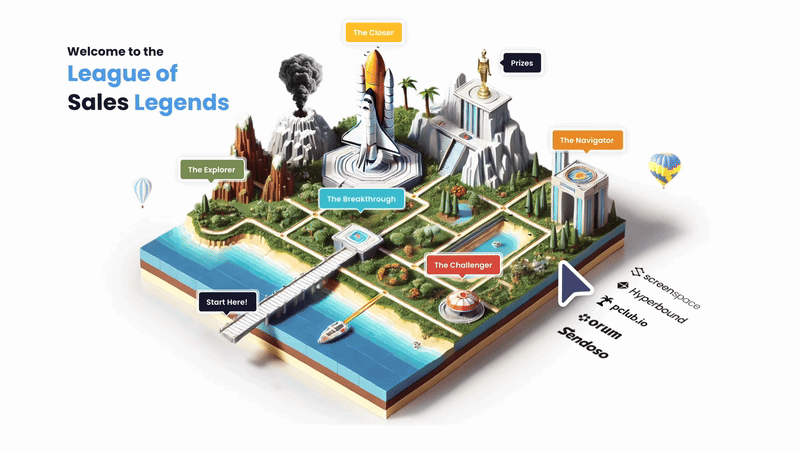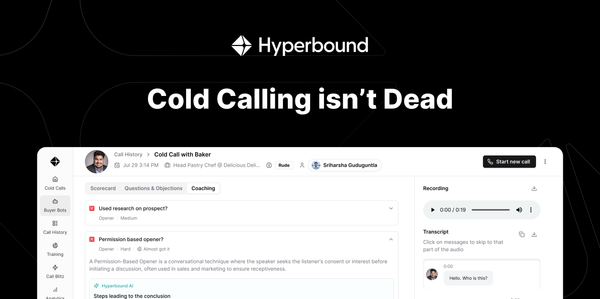Discovery Call Intros - Your Make or Break Moment

For elite sellers, every discovery call is a critical opportunity to set the tone, establish credibility, and pave the way for a productive relationship. While the entire call matters, the opening minutes can have an outsized impact on the deal’s trajectory. A successful discovery call intro is built on clear, confident actions that help you lead, rather than react.
So, what does it mean to "run your call" from the start, and how do you nail those first two minutes? Let’s break it down.
Showing Up on Time - The Professional Advantage of Being Early
In sales, timeliness goes beyond simple professionalism—it communicates respect, reliability, and leadership. If you show up exactly on time, you’re already behind. Being a few minutes early allows you to enter the call composed and ready, giving you control from the outset.
Practical Tips for a Timely Start:
- Log in 5 minutes early: Use this time to review any last-minute notes or reminders. If there’s a lobby for your meeting platform, arriving early places you in a ready position, reinforcing that the meeting is a priority.
- Test tech ahead of time: Connectivity issues can be frustrating for you and the client. Confirm your audio, camera, and internet connection are in good shape.
- Set the right tone with body language: Showing up early also gives you a moment to breathe, center yourself, and appear calm on screen. First impressions often form in a few seconds, so appearing calm and confident is essential.
Starting on time—or better yet, a few minutes early—helps you lead confidently, establishing that you’re a professional who values your client’s time and experience.
Knowing All Attendees - The Importance of Knowing Who’s in the Room
Discovery calls with multiple stakeholders can be challenging, especially when roles and decision-making authority vary. Instead of starting with generic introductions, come prepared with names, titles, and potential roles each attendee plays in the decision-making process. Showing this level of preparation and personalization signals that you’ve invested time to understand their team and goals.
How to Prepare for Attendee Dynamics:
- Review LinkedIn and company bios: Check LinkedIn profiles for relevant info on each participant’s role and background. Look for keywords and past experiences that align with their priorities in the buying process.
- Use a name-to-role cheat sheet: Create a quick reference with names, titles, and a short note on each attendee’s likely role in the project. This will help you engage directly, addressing people by name and role with ease.
- Acknowledge influencers and decision-makers: If you know someone influential is on the call, address their insights or potential concerns early. It shows you respect their input and understand the value of their perspective in the decision-making process.
This level of personalization and respect for your clients’ unique roles in the process doesn’t just save time—it makes a positive impact that can carry forward through the rest of the call and beyond.
Bringing Knowledge to the Table - Owning Your Expertise in the Room
Buyers don’t come to the table as “professionals” in buying software or solutions, so it’s on you to take the lead. From recent developments in their industry to pain points they may be experiencing, bringing relevant knowledge to the call frames you as a valuable partner rather than just another seller.
Strategies to Showcase Expertise:
- Conduct an industry deep dive: Familiarize yourself with recent trends or news that could impact their goals. Are there economic changes, technological advancements, or regulatory shifts affecting their field? Drop these insights subtly to demonstrate that you understand their landscape.
- Refer to past interactions and insights: Mention any relevant conversations your team has had with them, such as insights they shared in prior calls or points they emphasized in emails. This shows continuity and care, reassuring them that you value their unique perspective.
- Position yourself as a strategic resource: Use statements like, “I’ve worked with companies in similar situations, and they often find that X is a crucial factor.” By framing insights in terms of experience, you build credibility and establish a consultative role.
With knowledge and insights at the ready, you’re not just showing up to a call—you’re showing up as a resource who is already invested in their success.
Making Statements, Not Asks - The Art of Leading with Confidence
One of the most common mistakes in discovery calls is deferring too much to the client’s approval in your statements. While being polite is essential, overuse of phrases like “Does that make sense?” or “Is that okay?” can dilute your authority.
Tips for Confident Communication:
- Make bold, confident statements: Start with language that reinforces your knowledge and preparedness. Rather than saying, “Do you mind if I walk you through our process?” say, “Let’s walk through the plan we’ve outlined based on your priorities.”
- Use declarative language: Instead of “Does that sound good?” try, “Here’s how we typically proceed to achieve XYZ goal.” Phrasing things as statements rather than questions subtly reinforces your leadership role.
- Guide the conversation’s direction: Clients want a seller who can set the course confidently, not one who hesitates. Trust your knowledge and steer the conversation with authority, and they’ll feel reassured by your professionalism.
The result? By making statements rather than constantly seeking approval, you’ll project confidence, establishing yourself as a guide rather than a passive participant.
Final Thoughts: Owning the Start of Every Discovery Call
The first two minutes of a discovery call aren’t just small talk or procedural—this brief period lays the foundation for everything that follows. Elite sellers know that each interaction is an opportunity to establish authority, build trust, and show clients that they’ve come prepared.
By honing these small yet powerful elements of your discovery call intro, you’re setting yourself up for stronger client engagement, deeper trust, and a much smoother deal cycle overall.





